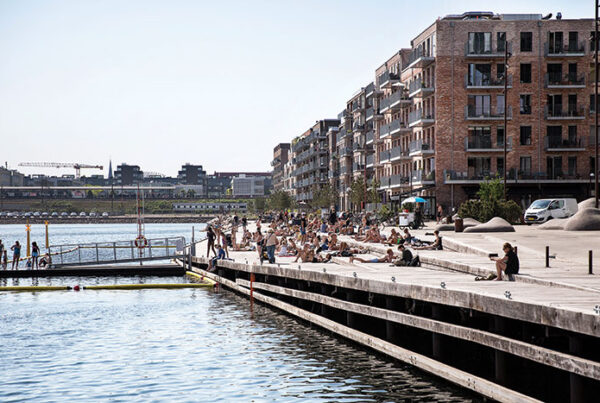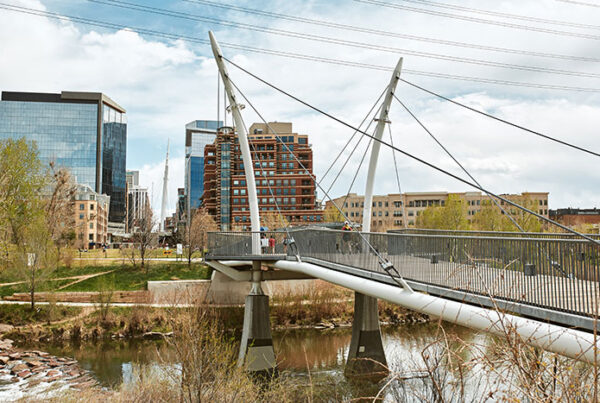
(Shutterstock)
ULI’s Building Healthy Places Initiative published Greening Buildings for Healthier People: Optimizing Climate Mitigation, Resilience, and Health Co-Benefits in Real Estate in March 2022. This three-part article series takes a closer look at some of these co-benefits and how they can promote project success locally while contributing to healthier cities, regions, and beyond.
The Intergovernmental Panel on Climate Change (IPCC) recently released the second part of its Sixth Assessment Report, a detailed publication that starkly outlines climate change’s threats to human and planetary health. This followed the 2021 release of a first part, which U.N. Secretary-General António Guterres called “a code red for humanity.”
The assessment warns that cities are expected to face increasingly severe climate hazards—affecting people’s health, infrastructure and transportation, and properties—but also have an outsized potential to help mitigate the worst of climate change. Because buildings are responsible for 40 percent of carbon dioxide emissions worldwide, low-carbon buildings are an essential part of addressing climate change.
At the same time, another crisis—the COVID-19 pandemic—has elevated health as a priority in real estate. Fortunately, as developers, owners, and operators seek to ensure that their buildings are safe, they do not have to choose between health and other critical ESG goals like carbon emissions reduction. ULI’s new report Greening Buildings for Healthier People: Optimizing Climate Mitigation, Resilience, and Health Co-Benefits in Real Estate identifies building-scale opportunities to simultaneously and cost-effectively accelerate action on climate change and health, maximize their co-benefits, and manage any tensions between them.
The report discusses the benefits of these strategies for tenants, communities, and real estate, but these strategies can also help to address global challenges. Buildings developed today will last for decades—the average life span of a commercial building is 60 years—and so integrating health and climate considerations now can help ensure that buildings are prepared for and will positively contribute to cities’ futures.
Several strategies in the report relate to low-carbon buildings, which aim to reduce the carbon in building materials and operations, with the ultimate goal of decarbonization. Implementing these strategies not only has a direct impact on tenant health, resilience to physical climate risks, and project success but also contributes to a broader vision for healthier cities and a more sustainable world.
Optimizing the Benefits of Low-Carbon Buildings

(Shutterstock)
Each of the climate mitigation strategies described below has corresponding benefits for tenant health and/or climate resilience. These strategies also advance project success by reducing costs (such as lowering energy bills or preventing disaster-related expenses), meeting tenant expectations for health-promoting features, and future-proofing buildings as city regulations and the real estate landscape evolve.
Embodied Carbon
Taking a life-cycle view of buildings, carbon emissions come from the processes used to create and transport building materials—not just building operations. Developers can reduce this embodied carbon by using fewer materials, by repurposing used materials as much as possible, and by selecting low-carbon materials, such as structural materials or lower-carbon carpeting. Strategies include:
- Using fewer materials. Lowering the presence of volatile organic compounds (VOCs) can improve health and help maintain a healthy level of indoor air quality, while also reducing total embodied carbon of the development.
- Choosing healthy building materials when seeking ones that are less carbon-intensive. These materials include low-formaldehyde products and low VOC paints, sealants, adhesives, fixtures, fit-outs, and flooring.
- Using materials that can withstand natural disasters, are nonflammable, and are mold-resistant. This minimizes the damage of extreme weather events and other natural disasters, and mitigates their health impacts.
Energy-Efficient Operations
One important component of energy efficiency in buildings is passive strategies that reduce the need for energy-intensive operations, such as insulation and cooling roofs. These strategies directly contribute to passive survivability during power outages, promote thermal comfort, and reduce the burden on heating, cooling, and lighting systems. Active measures, facilitated by advanced sensing and building controls, can also help reduce the energy used in building operations. Strategies include:
- Weatherizing buildings. Weatherization protects buildings from outdoor elements while reducing energy consumption and improving energy efficiency. This can also be a useful time to perform integrated pest management and eliminate allergens, to the extent possible, from the building.
- Installing high-efficiency HVAC equipment and programmable thermostats. These strategies improve energy efficiency while facilitating tenant comfort.
- Enhancing passive survivability. Keeping spaces cool and safe—especially during heat waves—without ramping up energy use is becoming increasingly important, even for temperate cities that will soon experience rising instances of extreme heat.
Decarbonization
Decarbonization is key to tackling climate change. Electrification allows buildings to switch their power sources from fossil fuels to cleaner forms of energy, serving as a powerful enabler of decarbonization that comes with related health benefits. Strategies include:
- Installing or upgrading appliances to electric versions. Gas stoves can emit indoor nitrogen dioxide levels exceeding indoor air quality guidelines and carbon dioxide levels exceeding even outdoor ambient air standards. Electric appliances directly result in better indoor air quality and health outcomes.
- Using heat pumps and all-electric systems. High-performance electric HVAC systems enhance thermal comfort, enabling tenants to control their own settings, have a quieter airflow, and know that the air is more effectively filtered. All-electric systems also reduce risk from natural gas infrastructure during disasters.
- Installing renewable energy onsite. In addition to aiding decarbonization, renewables can increase energy resilience during power outages. When tenants have reliable power sources, they can store refrigerated medications and benefit from improved business continuity.

(Shutterstock)
Climate and Health Impacts Beyond the Building
The benefits of these strategies extend beyond buildings themselves to communities, cities, and regions.
At the community scale, a small increase in long-term exposure to PM2.5 (a type of particulate matter that impacts respiratory health) leads to about an 8 percent increase in the COVID-19 death rate. The report discusses strategies to reduce the air pollution associated with burning fossil fuels as a benefit for tenant health, but it also has the potential to contribute to cleaner air community-wide. Noably, improving air quality also contributes to a stronger real estate environment.
Similarly, using nontoxic materials in construction minimizes health risks for the community in case a natural disaster or building collapse generates debris. And, energy-efficient buildings can lower the amount of waste heat they generate, which would otherwise contribute to the urban heat island effect and corresponding rates of heat illness in the community.
Looking beyond the immediate neighborhood, fossil fuel use affects communities along the supply chain, including environmental justice communities. (Because the environmental health impacts are less visible to the end user, tenants are often less likely to consider them.) The broader benefits of green and healthy buildings even extend to helping cities and nations achieve their climate goals. Although a single building contributes a relatively small amount to global emissions reductions, it is nevertheless a necessary part of this change.
“The scientific evidence is unequivocal: climate change is a threat to human wellbeing and the health of the planet,” says IPCC Working Group II co-chair Hans-Otto Pörtner. “Any further delay in concerted global action will miss a brief and rapidly closing window to secure a liveable future.” By taking a holistic approach to climate mitigation, resilience, and health, real estate professionals do not have to choose among their ESG priorities and can create successful, healthy, low-carbon projects locally while doing their part in advancing global climate action.





